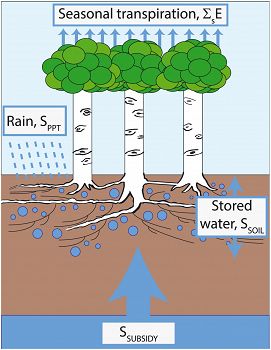Love et al., 2019
Dependence of Aspen Stands on a Subsurface Water Subsidy: Implications for Climate Change Impacts
Love D.M., Venturas M.D., Sperry J.S., Brooks P.D., Pettit J.L., Wang Y., Anderegg W.R.L., Tai X., Mackay D.S. (2019)
Water Resources Research 55(3): 1833-1848
-
Catalina-Jemez, INVESTIGATOR
Abstract
Conceptual diagram illustrating water sources for aspen stand seasonal transpiration and their representation in the one‐dimensional soil‐plant‐atmosphere model.
The reliance of 10 Utah (USA) aspen forests on direct infiltration of growing season rain versus an additional subsurface water subsidy was determined from a trait‐ and process‐based model of stomatal control. The model simulated the relationship between water supply to the root zone versus canopy transpiration and assimilation over a growing season. Canopy flux thresholds were identified that distinguished nonstressed, stressed, and dying stands. We found growing season rain and local soil moisture were insufficient for the survival of 5 of 10 stands. Six stands required a substantial subsidy (31–80% of potential seasonal transpiration) to avoid water stress and maximize photosynthetic potential. Subsidy dependence increased with stand hydraulic conductance. Four of the six “subsidized” stands were predicted to be stressed during the survey year owing to a subsidy shortfall. Since winter snowpack is closely related to groundwater recharge in the region, we compared winter precipitation with tree‐ring chronologies. Consistent with model predictions, chronologies were more sensitive to snowpack in subsidized stands than in nonsubsidized ones. The results imply that aspen stand health in the region is more coupled to winter snowpack than to growing season water supply. Winters are predicted to have less precipitation as snow, indicating a stressful future for the region's aspen forests.
Citation
Love D.M., Venturas M.D., Sperry J.S., Brooks P.D., Pettit J.L., Wang Y., Anderegg W.R.L., Tai X., Mackay D.S. (2019): Dependence of Aspen Stands on a Subsurface Water Subsidy: Implications for Climate Change Impacts. Water Resources Research 55(3): 1833-1848. DOI: 10.1029/2018WR023468
 This Paper/Book acknowledges NSF CZO grant support.
This Paper/Book acknowledges NSF CZO grant support.
Explore Further


